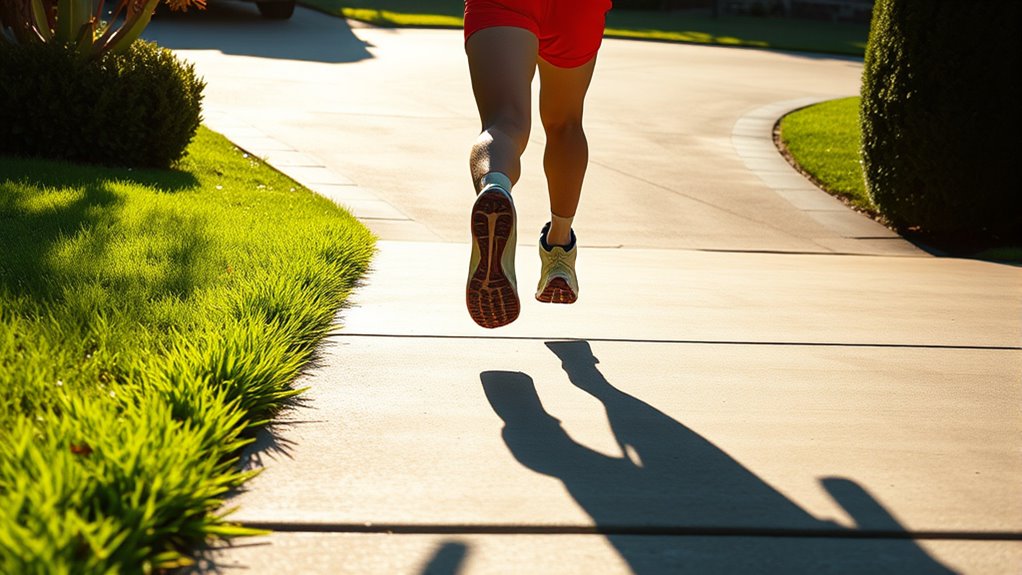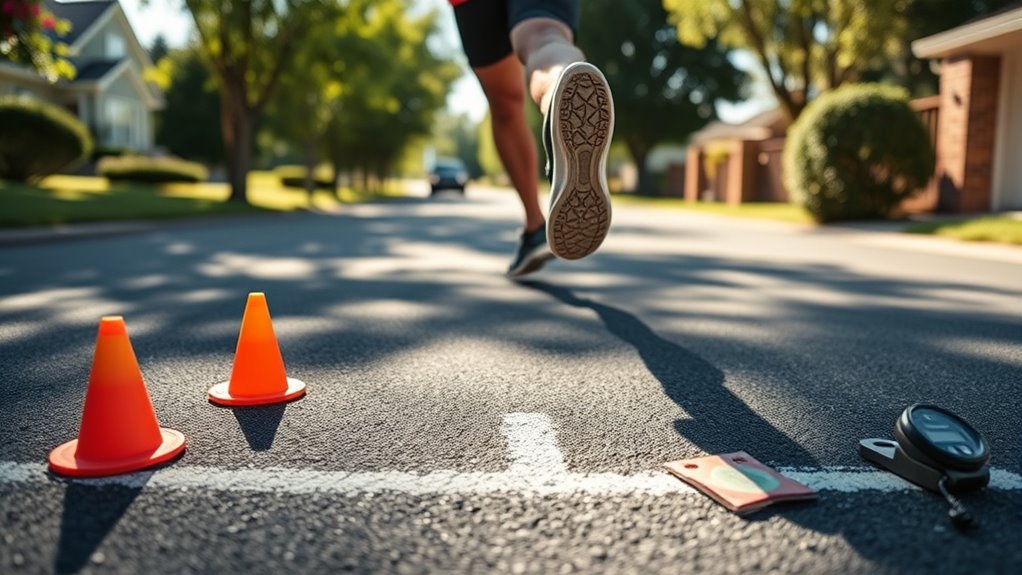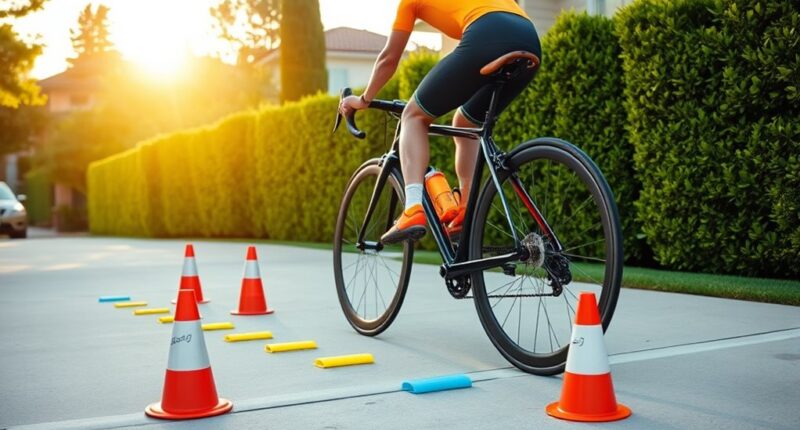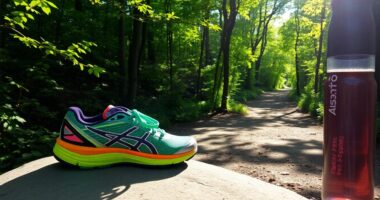You can improve your cadence right in your driveway with simple drills like marching in place with high knees to boost rhythm and arm coordination, or doing quick step shuffles to increase turnover speed. Focus on stride length with controlled arm swings and short sprints to develop power and speed. Practice cadence counting with a metronome or by counting steps aloud to stay consistent. Keep practicing these drills, and you’ll discover even more techniques to boost your running efficiency.
Key Takeaways
- Practice Marching in Place with High Knee Lift to improve cadence and core engagement.
- Use Quick Step Shuffles to train fast, light foot turnover in confined space.
- Perform Stride Length Focus Drills by extending steps with rhythmic arm swings.
- Incorporate 30-Second Sprint Intervals with a metronome for speed and rhythm.
- Count steps aloud or use a metronome app to develop consistent pacing and cadence awareness.
Marching in Place With High Knee Lift

To effectively improve your cadence, start by marching in place while lifting your knees high with each step. Focus on arm swing coordination to keep your body balanced and engaged. Swing your arms naturally, matching your arm movement to your knee lift, which helps maintain rhythm and momentum. Pay attention to your breathing rhythm—inhale deeply as you lift your knees and exhale as you lower them—this keeps your energy steady. Keep your core engaged and your movements controlled to build strength and consistency. This drill trains your body to move rhythmically, reinforcing a natural cadence. Practicing this regularly helps you develop a smooth, efficient stride, making it easier to increase your turnover and maintain a steady pace during your runs. Incorporating proper movement mechanics can further enhance your running efficiency and prevent injury. Focusing on proper posture alignment during your drills also supports overall stability and performance, and paying attention to training consistency will yield the best results over time. Additionally, paying attention to muscle engagement during each drill can maximize your training benefits.
Quick Step Shuffle to Boost Turnover

Have you ever wondered how to quickly increase your running cadence? The Quick Step Shuffle is perfect for boosting your stride cadence and foot turnover. To do this drill, stand in place and shuffle your feet rapidly, focusing on quick, light steps. Keep your knees slightly bent and maintain an upright posture. This movement trains your muscles to move faster without overstriding, improving overall cadence. Incorporating proper technique into your practice can help maximize your progress. Additionally, understanding cadence optimization principles can lead to more efficient running mechanics. Practicing this drill regularly can also help develop neuromuscular coordination, which is essential for maintaining high cadence during sustained runs. Focusing on muscle engagement during the shuffle can further enhance your ability to sustain increased cadence over longer distances.
Stride Length Focus Drills

Enhancing your stride length can considerably improve your running efficiency and speed. To do this, focus on maintaining a strong arm swing, which helps propel you forward and stabilize your body. Keep your arms relaxed and swing them in a controlled, rhythmic motion that matches your breathing rhythm. This synchronization encourages longer, more powerful strides without overexerting yourself. Practice drills where you intentionally extend each step, aiming for a deliberate and smooth stride. Pay attention to your posture, ensuring you stay upright with your chest open. By consciously working on arm swing and breathing rhythm, you’ll develop a more efficient stride length that boosts your overall running performance. Consistent practice will help these habits become second nature during your runs. Incorporating proper warm-up and cool-down routines can also prevent injuries and enhance your training effectiveness. Additionally, focusing on proper running form can maximize your stride efficiency and reduce fatigue over longer distances.
30-Second Sprint Intervals

Building on your focus of improving stride length, incorporating second sprint intervals can substantially boost your speed and stamina. During these drills, use metronome training to maintain a consistent rhythm, helping you develop better stride synchronization. Set the metronome to match your target cadence and focus on executing quick, powerful sprints for about 20-30 seconds. Rest briefly before repeating the interval. This approach sharpens your ability to stay in sync with your pace, maximizing efficiency and power. By consistently practicing second sprint intervals with metronome guidance, you’ll enhance your neuromuscular coordination, leading to more controlled and effective strides. Over time, this targeted training will translate into increased speed and endurance during your regular runs.
Cadence Counting and Pacing Practice

To improve your running efficiency, practicing cadence counting and pacing helps you stay aware of your rhythm and adjust your stride for ideal performance. Using metronome techniques allows you to set a steady beat, enhancing rhythm synchronization. This consistent pacing keeps you focused and prevents overstriding or understriding. You can incorporate simple drills such as counting your steps aloud or using a metronome app to match your cadence. These methods develop a natural sense of rhythm, making pace adjustments intuitive during runs. To deepen your practice, consider:
Practicing cadence and pacing with metronomes enhances running rhythm and efficiency.
- Setting specific cadence targets based on race distance
- Tracking your progress with a running journal
- Combining cadence drills with breathing exercises for better control
These strategies help embed cadence into your running, making it more efficient and enjoyable.
Frequently Asked Questions
How Often Should I Do These Driveway Cadence Drills Weekly?
You should aim for training frequency of 2 to 3 times a week for cadence drills in your driveway. This helps you build consistency without overtraining, reducing injury risk. Incorporate rest days to allow recovery and prevent strain. Regular practice improves your running efficiency, but listen to your body. Balancing workout intensity and recovery is key to injury prevention and steady progress in your running performance.
Can Beginners Safely Perform All These Drills Without Injury?
Sure, beginners can perform these drills, but don’t assume it’s risk-free. While proper running form and injury prevention are key, jumping into cadence drills without preparation might cause more harm than good. Start slow, focus on your technique, and listen to your body. With patience and proper guidance, you’ll build strength safely, turning a potentially risky workout into a stepping stone toward better running.
What Footwear Is Best for Performing These Driveway Cadence Exercises?
For cadence drills, you want running shoes with modern technology that offers lightweight support and cushioning. Look for footwear with good durability to withstand frequent use, especially if you’re doing drills on concrete or asphalt. Choose shoes that fit well, provide arch support, and help absorb impact. This guarantees comfort, reduces injury risk, and maximizes your training benefits during driveway exercises.
How Do I Measure Progress in My Cadence and Pacing?
To measure progress in your cadence and pacing, focus on your stride length and step rate. Track how many steps you take per minute using a stopwatch or a running app. Over time, you’ll notice improvements when your step rate increases or your stride length becomes more efficient at the same pace. Consistent tracking helps you see gains and adjust your training to maintain steady progress.
Are There Any Warm-Up or Cool-Down Routines Recommended?
Like a knight prepping for battle, you should start with a gentle warm-up to avoid injury. Incorporate stretch routines that focus on your legs and hips, and stay hydrated with proper hydration tips. After your workout, cool down with light jogging or walking, followed by more stretching to improve flexibility. This routine helps prevent soreness and keeps you ready for your next run, ensuring your body stays in top shape.
Conclusion
Now, with these driveway drills, you’ll turn into a running legend faster than a cheetah on rocket fuel! Your cadence will be unstoppable, your turnover faster than a lightning strike, and your stride longer than the Great Wall of China. Before you know it, you’ll be crushing races, leaving competitors in a cloud of dust, and making everyone wonder if you’ve secretly unveiled the secret to running like a superhero. Get out there and make that driveway your launchpad to greatness!








